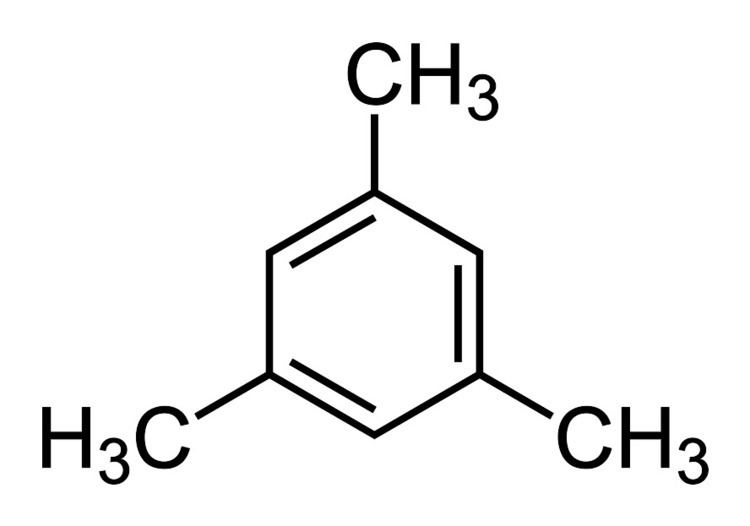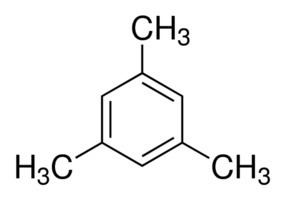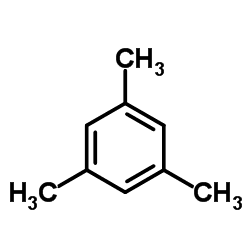Formula C9H12 Molar mass 120.19 g/mol Melting point -44.8 °C | Boiling point 164.7 °C Density 864 kg/m³ | |
 | ||
Appearance Clear, colorless liquid | ||
Mesitylene or 1,3,5-trimethylbenzene is a derivative of benzene with three methyl substituents positioned symmetrically around the ring. The other two isomeric trimethylbenzenes are 1,2,4-trimethylbenzene (pseudocumene) and 1,2,3-trimethylbenzene (hemimellitene). All three compounds have the formula C6H3(CH3)3, which is commonly abbreviated C6H3Me3. Mesitylene is a colourless liquid with sweet aromatic odor. It is a component of coal tar, which is its traditional source. It is a precursor to diverse fine chemicals. The mesityl group (Mes) is a substituent with the formula C6H2Me3 and is found in various other compounds.
Contents

Preparation
Mesitylene is prepared by equilibration of xylene (or simple methyl alkylation of it) over solid acid catalyst:

Although impractical, it could be prepared by trimerization of propyne, also requiring an acid catalyst, affords a mixture of 1,3,5- and 1,2,4-trimethylbenzenes.
Catalyzing and dehydrating by sulfuric acid, trimerization of acetone via aldol condensation also affords mesitylene.
Reactions

Oxidation of mesitylene with nitric acid affords trimesic acid, C6H3(COOH)3. Using manganese dioxide, a milder oxidising agent, 3,5-dimethylbenzaldehyde is formed. Mesitylene is oxidised by trifluoroperacetic acid to produce mesitol (2,4,6-trimethylphenol).
Applications
Mesitylene is mainly used as a precursor to 2,4,6-trimethylaniline, a precursor to colorants. This derivative is prepared by selective mononitration of mesitylene, avoiding oxidation of the methyl groups.
Additive and component of some avgas (aviation gasoline) blends.
Niche uses
Mesitylene is used in the laboratory as a specialty solvent. It can also act as a ligand in organometallic chemistry, one example being the organomolybdenum complex [(η6-C6H3Me3)Mo(CO)3]. which can be prepared from molybdenum hexacarbonyl.
In the electronics industry, mesitylene has been used as a developer for photopatternable silicones due to its solvent properties.
The three aromatic hydrogen atoms of mesitylene are in identical chemical shift environments. Therefore, they only give a single peak near 6.8 ppm in the 1H NMR spectrum. For this reason, mesitylene is sometimes used as an internal standard in NMR samples that contain aromatic protons.
Uvitic acid is obtained by oxidizing mesitylene or by condensing pyruvic acid with baryta water.
History
Mesitylene was first prepared in 1837 by Robert Kane, an Irish chemist, by heating acetone with concentrated sulfuric acid. He named his new substance "mesitylene" because the German chemist Carl Reichenbach had named acetone "mesit" (from the Greek μεσίτης, the mediator), and Kane believed that his reaction had dehydrated mesit, converting it to an alkene, "mesitylene". However, Kane's determination of the chemical composition ("empirical formula") of mesitylene was incorrect. The correct empirical formula was provided by August W. von Hofmann in 1849. In 1866 Adolf von Baeyer showed that mesitylene's structure was consistent with that of 1,3,5-trimethylbenzene; however, conclusive proof that mesitylene was identical to 1,3,5-trimethylbenzene was provided by Albert Ladenburg in 1874.
Mesityl group
The group (CH3)3C6H2- is called mesityl (organic group symbol: Mes). Mesityl derivatives, e.g. tetramesityldiiron, are typically prepared from the Grignard reagent (CH3)3C6H2MgBr. Due to its large steric demand, the mesityl group is used as a large blocking group in asymmetric catalysis (to enhance diastereo- or enantioselectivity) and organometallic chemistry (to stabilize low oxidation state or low coordination number metal centers). Larger analogues with even greater steric demand, for example 2,6-diisopropylphenyl (Dipp) and the analogously named Tripp ((iPr)3C6H2, Is) and supermesityl ((tBu)3C6H2, Mes*) groups, may be even more effective toward achieving these goals.
Safety and the environment
Mesitylene is also a major urban volatile organic compound (VOC) which results from combustion. It plays a significant role in aerosol and tropospheric ozone formation as well as other reactions in atmospheric chemistry.
